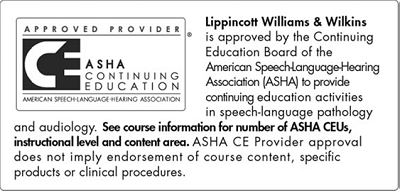{{ (moduleVm.actions && moduleVm.changeStatus) ? moduleVm.status : '' }} Treatment Approach Considerations for Children with Speech Sound Disorders in School-based Settings
Activity Steps
{{ evaluation.question.text }}
{{choice.text}}
{{evaluation.answerSet[0].text}}
Description
Note: ASHA CEUs cannot be reported to ASHA unless your ASHA member number is included in your profile. Over the past 12 years, on average, over 90% of school-based SLPs reported treating speech-sound disorders (SSDs), one of the most common types of pediatric communication disorders. Children with an SSD are at increased risk academically, socially, and economically (i.e., employment opportunities). School-based SLPs, need a variety of evidence-based interventions at their disposal to effectively treat these children. Using case studies, the authors describe and contrast a traditional motor articulatory-based approach with phonologically-based intervention approaches. Accreditation
This course is offered for 0.05 ASHA CEUs
(Intermediate Level, Professional Area).
Purpose of Activity
To gain knowledge on determining the best suited intervention approach for pediatric speech sound disorders (SSDs).Learning Objectives
After completing this continuing education activity you will be able to:
- Summarize multiple intervention approaches for speech sound disorders (SSDs).
- Explain targets associated with certain intervention approaches to elicit accurate production.
- Identify which approach is best suited for pediatric clients presenting with SSD.
Disclosures
Kathryn L. Cabbage, PhD, CCC-SLP has no financial disclosures or potential conflicts of interest.
Shari L. DeVeney, PhD, CCC-SLP has no financial disclosures or potential conflicts of interest.
Price:
$15.00
Credits:
- ASHA 0.05 CEU
Lippincott Williams & Wilkins is approved by the Continuing Education Board of the American Speech-Language-Hearing Association (ASHA) to provide continuing education activities in speech-language pathology and audiology. ASHA CE Provider approval does not imply endorsement of course content, specific products or clinical procedures. This course is offered for 0.05 ASHA CEUs (Intermediate Levels, Professional Area).
{{ evaluation.question.text }}
{{choice.text}}
{{evaluation.answerSet[0].text}}
Professions:
Audiologist, Speech-Language Pathologist
Test Code: TLD4201
Published: Oct/Dec 2020
Expires: 10/31/2025
Sources:
Topics in Language Disorders
Required Passing Score: 4/5 (80%)
Specialties:
Communication,
Speech
Topics:
Communication
,
Speech Sound Disorder (SSD)